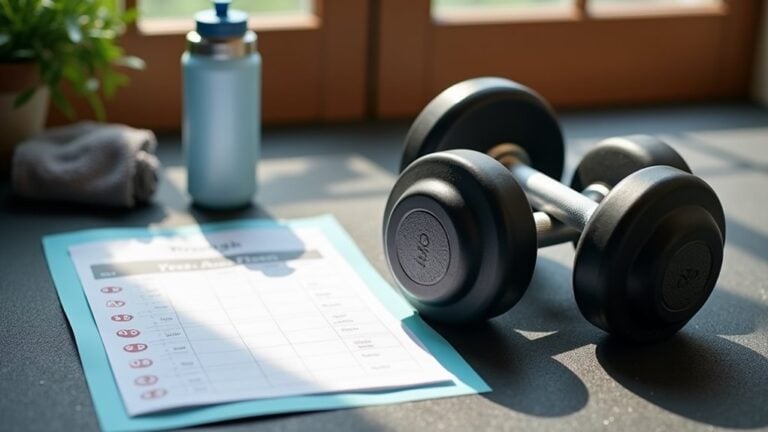Vital hip abductors play an indispensable role in preserving knee stability and alleviating strain during motion, yet many individuals disregard these muscles until discomfort emerges. Weakness in this region can result in imbalances, poor posture, and even knee pain over time. Simple exercises like side leg raises or resistance band walks can make a perceptible difference in strength and joint support. The appropriate regimen not only enhances stability but also boosts general mobility, rendering everyday activities more effortless. Those seeking to shield their knees may discover these focused movements remarkably efficient.
Standing Side Leg Raises for Hip Strength
Standing side leg raises strengthen the hip abductors, the muscles responsible for moving the leg away from the body. This exercise boosts hip strength and improves knee stability through targeting the outer thigh and glute muscles.
To perform it, stand upright with a resistance band looped around the ankles or use no band for an easier option. Lift one leg sideways, keeping the back straight and holding onto a chair or wall for balance. Squeeze the hip abductors at the top of the movement before lowering slowly.
Using an ankle cuff weight adds resistance for strength training. Avoid leaning or twisting to isolate the muscles appropriately. Consistent leg raises augment hip abduction, reducing strain on the knees and ameliorating overall lower-body stability.
Standing Leg Wall Press to Improve Stability
The standing leg wall press offers a simple yet effective way to build hip strength while keeping balance in check. This hip-strengthening exercise targets the hip abductor muscles, which play a key role in stabilizing the knee joint and improving overall lower-body strength. Through pressing the leg into the wall, the movement creates resistance, helping to activate the muscles without straining the joints.
- Stability Boost: The wall provides support, reducing the risk of imbalance while still challenging the hip abductors.
- Controlled Resistance: Holding the wall push for 3-5 seconds increases muscle engagement without overloading the knee.
- Progression Options: Adding a slight bend to the supporting leg intensifies the workout, further enhancing strength and control.
This exercise is ideal for those seeking better stability and functional movement.
Side Lying Leg Raises for Targeted Abduction
Side lying leg raises zero in on the hip abductors with precision, offering a straightforward way to build strength without fancy equipment. This exercise engages the gluteus medius, a key muscle for stabilizing the hip joint and supporting weight-bearing joints like the knees. Through lifting the top leg while lying sideways, individuals with a weak hip or knee osteoarthritis can gradually improve strength and reduce strain. The movement involves holding the leg up briefly before lowering slowly, ensuring controlled muscle activation.
| Key Benefits | How to Perform |
|---|---|
| Targets hip abductor muscles | Lie on side, keep body straight |
| Improves stability | Lift top leg, hold for 2 seconds |
| No equipment needed | Lower slowly over 3 counts |
Consistency with side lying leg raises helps counteract muscle imbalances, promoting better overall joint health.
Crab Walking With Resistance Bands
Resistance bands turn a simple sideways walk into a powerhouse move for the hips, effortlessly engaging those often-neglected abductor muscles. Crab walking with a resistance band around the legs strengthens the hip abductor while improving balance and stability.
To perform it, step sideways in a controlled lateral movement, keeping the knee over the foot to avoid strain. Adjusting resistance levels challenges strength and control, making it adaptable for all fitness levels.
- Builds Stability: The sideways motion strengthens muscles that support the knees, reducing imbalance.
- Enhances Control: Focusing on form prevents inward knee collapse, promoting safer movement.
- Adaptable Intensity: Lighter bands ease beginners in, while heavier ones push endurance.
This exercise is a practical way to boost lower-body strength without complex equipment, making it ideal for home workouts.
Hip Hitch for Functional Strength
Standing on one leg could appear simple until the hip begins to sway—that’s where the hip hitch enters the image. This exercise targets the gluteus medius, a key hip abductor that stabilizes the pelvis during single-leg movements.
Through lifting one hip upward while keeping the opposite foot grounded, the hip hitch trains the lower extremity to maintain alignment, reducing strain during practical tasks like walking or stair climbing. Weakness in these muscles often leads to poor mechanics, increasing injury risk.
The movement’s simplicity makes it accessible, yet its impact on stability is significant. Regularly incorporating hip hitches can improve balance, support joint health, and elevate performance in daily activities, making it a practical addition to any routine focused on functional strength.
Bridge With Banded Abduction for Core and Hip Support
The bridge with banded abduction requires proper band placement just above the knees to maximize activation of the hip abductors during the lift. Preserving controlled movement with the core engaged and hips level guarantees the exercise strengthens both the glutes and stabilizing muscles without compromising form.
Beyond focusing on the hips, this variation builds core stability by resisting the band’s inward pull while keeping the pelvis steady.
Band Placement and Positioning
Whenever employing a resistance band for hip abduction exercises like the bridge, proper placement is key to targeting the right muscles efficiently. The band should sit just above the knees or around your ankles, depending on the exercise variation.
For the bridge, positioning it above the knees engages the glutes and outer thighs while stabilizing the ball and socket joint of the hip.
- Above the knees: Ideal for beginners, as it reduces strain on the hip flexors and highlights the standing leg during movements like band walking.
- Around your ankles: Boosts resistance, challenging the Lying Leg abduction more intensely but requires better control.
- Tension level: A lighter band guarantees proper form, while a heavier one builds strength but could compromise alignment if not used cautiously.
Correct placement ensures the band works with the body, not against it.
Movement Execution and Form
To get the most out of the bridge with banded abduction, starting with proper form guarantees both safety and effectiveness. Begin through lying on the back with knees bent, feet flat, and a resistance band looped around the thighs just above the knees.
Tightening the abdominal muscles engages the core while lifting the hips slowly raise them until forming a straight line from knees to shoulders. Pressing the knees outward against the band activates the hip abductor muscles, supporting stronger knee joints. The movement also helps stabilize the lower body, which can indirectly help you lose weight by improving functional strength.
Lower the hips back down with control, keeping the core engaged. Repeating this exercise builds endurance while maintaining proper alignment around the hips and knees.
Benefits for Core Stability
Because the bridge with banded abduction actively engages both the core and hip muscles, it builds stability that carries over into everyday movements. The resistance band increases tension, forcing the glutes and obliques to work harder, which improves comprehensive balance and posture. According to *Healthline Media*, this exercise helps strengthen the hip abductors while reinforcing core endurance—key for preventing injuries.
Peer-reviewed studies highlight the effect of hip abductor training on strength and stability, with systematic reviews confirming its role in enhancing movement control.
- Targeted Activation: The banded abduction increases glute and oblique engagement more than a standard bridge.
- Functional Benefits: Strengthening these muscles supports better alignment during walking, lifting, or standing.
- Injury Prevention: A strong core and hip system reduces strain on the knees and lower back.
The effects of hip abductor exercises extend beyond the gym, promoting long-term mobility.
Conclusion
Strengthening the hip abductors is a transformative development for knee stability and lower-body strength. These exercises build resilience in the gluteus medius and surrounding muscles, helping you move with confidence and ease. Whether you’re recovering from an injury or just aiming for better balance, consistency pays off. Recall—small efforts add up, and before you know it, you’ll be standing tall, steady as a rock, with knees that feel unstoppable. Persist at it, and the results will follow.




